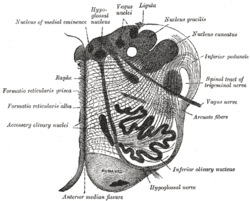Posterior external arcuate fibers
| Posterior external arcuate fibers | |
|---|---|

Diagram showing the course of the arcuate fibers. (Testut.) 1. Medulla oblongata anterior surface. 2. Anterior median fissure. 3. Fourth ventricle. 4. Inferior olivary nucleus, with the accessory olivary nuclei. 5. Gracile nucleus. 6. Cuneate nucleus. 7. Trigeminal. 8. Inferior peduncles, seen from in front. 9. Posterior external arcuate fibers. 10. Anterior external arcuate fibers. 11. Internal arcuate fibers(no it's olivocerebellar tract). 12. Peduncle of inferior olivary nucleus. 13. Nucleus arcuatus. 14. Vagus. 15. Hypoglossal.
|
|

Section of the medulla oblongata at about the middle of the olive. (Arcuate fibers labeled at center right.)
|
|
| Details | |
| Identifiers | |
| Latin | fibrae arcuatae externae posteriores |
| NeuroLex ID | Cuneocerebellar tract |
|
Anatomical terminology
[]
|
|
The posterior external arcuate fibers (dorsal external arcuate fibers) take origin in the accessory cuneate nucleus ; they pass to the inferior peduncle of the same side.
It carries proprioceptive information from the upper limbs and neck. It is an analogue to the dorsal spinocerebellar tract for the upper limbs. In this context, the "cuneo-" derives from the accessory cuneate nucleus, not the cuneate nucleus. (The two nuclei are related in space, but not in function.)
The term "cuneocerebellar tract" is sometimes used to collectively refer to the posterior external arcuate fibers.
The term "cuneocerebellar tract" is also used to describe an exteroceptive component that take origin in the gracile and cuneate nuclei; they pass to the inferior peduncle of the same side.
It is uncertain whether fibers are continued directly from the gracile and cuneate fasciculi into the inferior peduncle.
This article incorporates text in the public domain from the 20th edition of Gray's Anatomy (1918)
Dissection of brain-stem. Lateral view.
Deep dissection of brain-stem. Lateral view.
Dissection of brain-stem. Dorsal view.
...
Wikipedia
